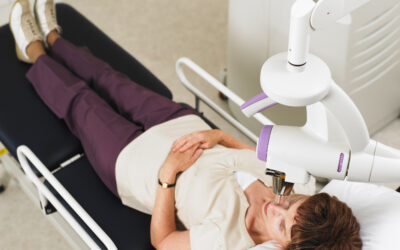BACKGROUND:
Our first trial on radiotherapy for painful heel spur published in 2012 comparing the analgesic effect of a standard dose (6 × 1.0Gy within three weeks) to that of a very low one (6 × 0.1Gy within three weeks) resulted in a highly significant superiority of the standard dose arm. In the meantime, experimental data have shown that lower single doses in the range of 0.5 – 0.7Gy might be even more effective than the current standard dose of 1.0 Gy. Therefore, we conducted a second trial comparing the analgesic effect of standard single doses of 1.0Gy to that of low single doses of 0.5Gy using uniform total doses of 6Gy.
PATIENTS AND METHODS:
One hundred twenty-seven patients were randomized to receive radiation therapy either with a total dose of 6.0Gy applied in 6 fractions of 1.0Gy twice weekly (standard dose) or with the same total dose applied in 12 fractions of 0.5Gy three times weekly (experimental dose). In all patients lateral opposing 6MV photon beams were used. The results were measured using Visual analogue scale (VAS), Calcaneodynia score (CS) and SF-12 health survey. The first phase of this trial ended after a three months’ follow-up; it will be continued up to 48 weeks.
RESULTS:
Nine patients had to be excluded after randomization either due to the withdrawal of informed consent to radiotherapy by the patients or radiotherapy with an incorrect dosage. The groups were comparable concerning biographical and disease data. The mean calcaneodynia score (CS) was higher in the experimental group (p = 0.002). After three months’ follow-up, we saw a very favorable pain relief in both arms (decline of VAS score: standard arm 42 points, experimental arm 44 points (n.s.), but we did not notice any statistically significant difference between the arms neither concerning the pain parameters nor the quality of life parameters. No relevant acute side effects were recorded.
CONCLUSIONS:
Favorable laboratory results could not be translated into an enhanced pain relief in our patients. This trial was terminated after the interim analysis (127 patients randomized). Further trials will be necessary to explore the best fractionation schedule.
This trial has been approved by the expert panel of the DEGRO as well as by the Ethics committee of the Saarland Physicians’ chamber.
TRAIL REGISTRATION:
Current trial registration at German Clinical Trials Register with the number DRKS00004458
Marcus Niewald,corresponding author Henrik Holtmann, Benjamin Prokein, Matthias G. Hautmann, Hans-Peter Rösler, Stefan Graeber, Yvonne Dzierma, Christian Ruebe & Jochen Fleckenstein






